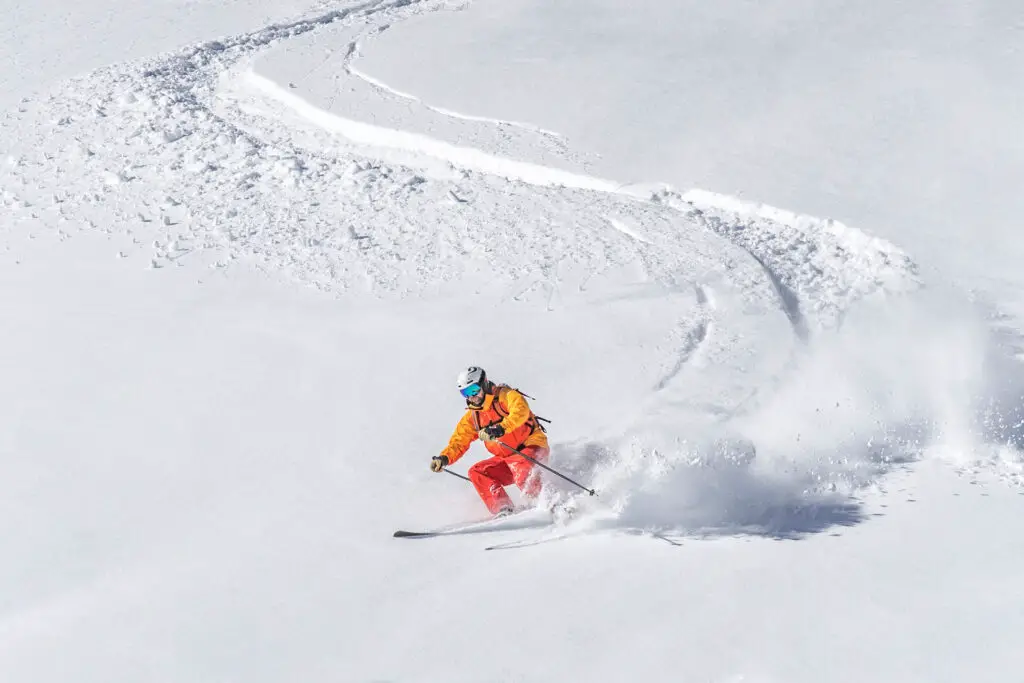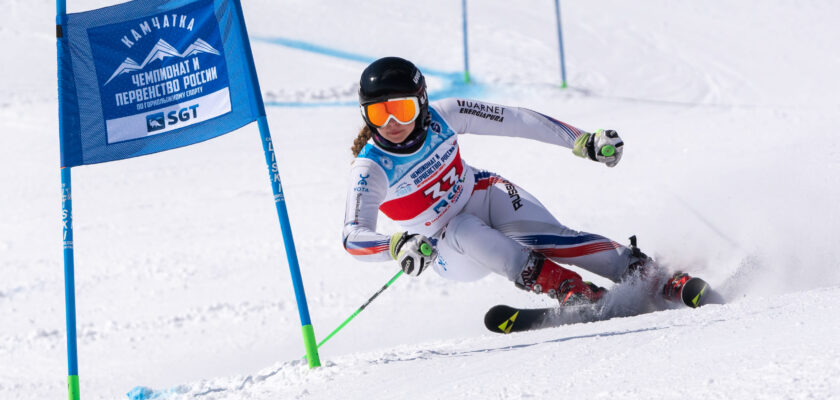Skiing consists of two blades about 2 meters long and 8 centimeters wide, designed to allow people to glide across the snow. Over time, the sport has become an Olympic discipline and is competed in by both men and women in the slalom, giant slalom and superslalom disciplines. Today we’re going to tell you all about Alpine Skiing!
Aopen your Betano account and get up to 1,000 reais in bonuses.
Payments via PIX, live games and super odds!
Click here to open your account!
All about Alpine Skiing: what is it?
Alpine skiing is one of the branches of skiing and is characterized as a sport that requires technique and speed, as well as a significant aerobic capacity and muscular endurance in the legs.
As it requires the presence of snow, it is practiced especially during the winter season.
In alpine skiing, athletes race down a steep slope at full speed, dodging obstacles along the way. The main objective is to complete the descent in the shortest time possible.
In addition, competitors wear helmets to protect against possible impacts with the snow, other skiers or obstacles on the slope.
Read to the end and learn all about alpine skiing!
All about Alpine Skiing: history
Skiing has a long history. The formation of modern skiing is generally attributed to the 1850s, when the famous Norwegian skier Sondre Norheim popularized skis with curved sides, the rigid side heel bindings made of willow, as well as the Telemark and Christiania (slalom) turn techniques.
The roots of skiing can be traced back to prehistoric times, evidenced by the discovery of wooden planks of various sizes and shapes preserved in peat bogs in Russia, Finland, Sweden and Norway.
Fragments of skiing found in Russia date back to around 8,000-7,000 BC, indicating that a form of skiing was part of life in colder countries thousands of years ago.
Skiing went from being used as a means of transportation to becoming a sport at the end of the 19th century. The first non-military competitions took place in the 1840s in northern and central Norway;
Read to the end and learn all about alpine skiing!
The first national ski competition in Norway, held in Christiania (now Oslo) and won by Sondre Norheim in 1868, is considered the starting point of a new era of enthusiasm for the sport;

In the following decades, skiing spread to Europe and the United States, where miners organized competitions for winter fun;
The first slalom tournament was organized by Sir Arnold Lunn in 1922 in Mürren, Switzerland. Men’s and women’s alpine skiing were included in the Olympic program in 1936 in Garmisch-Partenkirchen;
That year, only a combined downhill and slalom competition was held. In 1948, separate downhill and slalom races were introduced;
Four years later, the giant slalom was added, and in 1988, the supergiant slalom became the sport’s fourth event.
Read to the end and learn all about alpine skiing!
All about Alpine Skiing: what races are there?
There are 5 types of competitions in alpine skiing: downhill, super-G, giant slalom, combined and mixed team parallel slalom. Check out the specifics of each one now!
Downhill
Many consider downhill skiing to be the main discipline of alpine skiing, the literal term for “going downhill”. The competitor who completes the course the fastest is the winner.
Typical speeds in this event can reach around 130 km/h, but on some tracks they can be even higher;
In 2013, French skier Johan Clarey made a name for himself by exceeding the 160 km/h mark at a World Cup stage in Wengen Lauberhorn, Switzerland.
Read to the end and learn all about alpine skiing!
Jumps of tens of meters are common in downhill. If the narrator mentions that the skier is looking like a windshield when jumping, this indicates an improper posture.
The ideal position is the carpada, where the skier keeps their arms close to their body to ensure balance.
The runners have to go around gates, which mainly serve to prevent shortcuts, since the course is defined by the natural configuration of the terrain.
Downhill skiers tend to be taller and heavier than technical skiers, requiring great leg strength.
Being the longest course and with the highest speeds, skiers often throw themselves on the ground at the finish line to relieve the strain on their legs, which are exhausted from lactic acid.
Competitors often do several warm-up runs before the race, which helps to identify those who are familiar with the track and in good physical shape;
Read to the end and learn all about alpine skiing!
Super-G
The super-G, which stands for super giant slalom, is a discipline that combines the speed of downhill with the precision of giant slalom turns.
In this event, there is less difference in altitude compared to downhill and the gates are closer together.Each skier makes a descent, and whoever completes the course fastest wins.
The special thing about super-G is that skiers can’t warm up on the slope; they only have 90 minutes on the morning of the race to inspect the venue and discuss the details of the course with their coaches. The route must be memorized!
That’s why it’s common to see skiers at the start of the slope, waiting for their turn, with their eyes closed, visualizing the route and practicing the movements mentally to memorize it.
Read to the end and learn all about alpine skiing!
Giant Slalom
Considered the fastest technical race, the giant slalom is performed in two descents on the same day, and the winner is determined by the sum of the times of the two passes.
The routes vary and skiers can reach speeds of up to 80 km/h. On the second descent, the starting order is reversed, beginning with the top 30 finishers from the first race.
Read to the end and learn all about alpine skiing!
Combined
The combined event, which is mainly held at the Olympic Games and has been excluded from the World Cup calendar for two consecutive seasons, is aimed at the most versatile alpine skier.
Generally, the format includes a downhill (or super-G) and a slalom, all on the same day.
The times of the two descents are added together to determine the winners, testing the skiers’ technical and speed skills to the maximum, as well as their physical endurance.
Read to the end and learn all about alpine skiing!
Mixed Team Parallel Slalom
The mixed team parallel slalom made its debut at PyeongChang 2018 and quickly became popular, as skiers compete in duels on two identical slopes, positioned side by side;
Viewers have the chance to follow who won and see their reactions, especially at crucial moments.
Each country registers four skiers, two of each gender, who compete against the four skiers from another nation in each round, accumulating one point per victory in each race;
After four races, if there is a tie, the team with the best overall time is declared the winner. The competition begins with the round of 16 and progresses to the final.
The interesting challenge for skiers is to be able to concentrate on their own descent, even with their opponent close behind, possibly just a foot ahead.
Read to the end and learn all about alpine skiing!
All about Alpine Skiing: rules and regulations
Alpine skiing competitions follow a set of specific rules established by the International Ski Federation (FIS). Here are some of the main rules and characteristics of the competitions:
Equipment
- Skis: must be within the length and width limits established for each sport.
- Boots: must ensure adequate control and safety, with specific rules for attaching to skis.
- Protection: helmets are compulsory. In some competitions, other protective equipment, such as knee and elbow protectors, may be required.
Route
Remembering…
- Slalom: has the shortest route and the closest doors. The doors must be passed in a specific sequence and can include quick changes of direction.
- Giant Slalom: the course is longer and the gates are more widely spaced than in slalom. It requires a combination of speed and technique.
- Downhill: the fastest race, with a long course and lots of turns and jumps. Skiers compete at high speeds.
- Super-G: combines elements of downhill and giant slalom, with less vertical drop than downhill and closer gates than giant slalom.
Read to the end and learn all about alpine skiing!
Test format
The racecan be held in one or two descents, depending on the discipline. The total time of the descents determines the winner.
In events such as the parallel slalom, competitors can face each other in a knockout format, with the winners advancing to the next stages.
Classification
The times are usually added together from the two descents to determine the final ranking. In the event of a tie, additional criteria, such as the best time on a descent, can be used.
Security
Skiers must follow the safety rules, avoiding dangerous maneuvers or conduct that could put the physical integrity of other participants at risk.
The track must be properly marked and inspected before the competition to ensure the safety of the athletes.
Read to the end and learn all about alpine skiing!
Conduct of athletes
Skiers must follow the instructions of the referees and respect the rules of sports conduct. Any inappropriate behavior may result in penalties or disqualification.
Rules
- Don’t put yourself or others at risk;
- Adapt your speed to your skills, the terrain and the conditions;
- Respect the obligation to give way to the skiers and snowboarders in front of you;
- Always keep enough room for both intentional and unintentional movements when overtaking another skier or snowboarder;
- Avoid stopping or sitting in narrow or hidden areas;
- It is advisable to learn how to interpret a ski map in order to correctly follow the trail signs, markings and directions;
- Everyone has a responsibility to help in the event of accidents or injuries.
Want to know more about other sports that you’re not used to following? Now that you know all about downhill skiing, read on:





